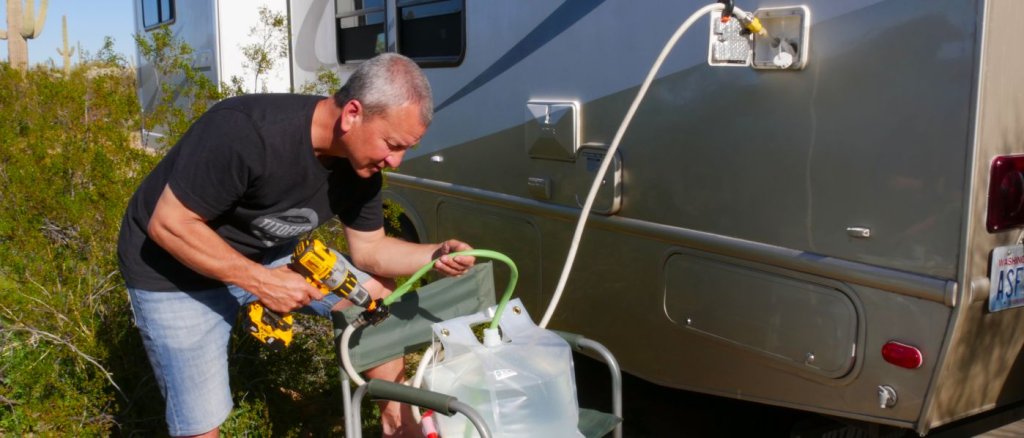It doesn’t matter how often you hit the road in your RV; you’ll always need a steady supply of clean water for cooking and bathing. Refill the water tanks with fresh water during dry camping. Having access to clean water is essential for a comfortable journey.
Although the layout of each tent is unique, some provide a place to store potable water. When not connected to an external water source, you can utilize this convenient system for drinking, cooking, dishwashing, showering, and toilet flushing.
How to drain an RV’s fresh water tank and fill it is an absolute must.
When to Fill Fresh Water Tank on RV

A freshwater tank is a storage container for potable water in a recreational vehicle. Maintaining clean water in your freshwater tank requires regular sanitation and a high-quality water filter. However, if you plan to leave your RV parked for a few months, drain the tank, flush the system with new water from a reliable source, refill the tank, and sanitize it thoroughly before leaving.
Follow these simple steps to know when you should fill your RV tank:
1. Verify Water Storage of Your RV
You should first check the indicator because the equipment will help you see the recreational vehicles’ water level. You will get this water tank indicator inside the RV near the dashboard. It is straightforward to note how much water is remaining in the RV.
2. Monitor Your Water Usage
You should monitor the daily water consumption on your trip. Moreover, uncontrolled water usage during bathing, cooking, and other household cleaning supplies can quickly deplete the water level. If you feel like you will run off water, refill the water task as soon as possible.
3. Plan for Renewal
Before starting your journey, filling water in the station near your campgrounds or other locations within the driving distance is better. One strategy to ensure you have plenty of water while boondocking is to fill up your extra containers before you leave for your destination.
4. Use Water per This Formula
Depending on the size of your recreational vehicle, a standard freshwater tank can hold anywhere from twenty to one hundred gallons of water. You can roughly estimate Water requirements using the formula 2–4 gallons per person daily.
It will meet Your water requirements for dishwashing and cooking within this. The number of persons in your group will decide how far you can go before filling up again. You should be extra careful with water while camping because it is scarce.
Steps to Refill Your Fresh Water Supply in RV
- To get clean water, find a hose. Make sure it is FDA-approved for use with drinking water and won’t change your water’s flavor.
- To hook up your water supply, park as close as possible to the fixture.
- Join the fresh water hose’s connector to the sink’s spout. Therefore, ensure the connection is solid and secure to avoid leakage.
- Connect the other end of the hose to the RV’s freshwater supply by screwing it in.
- An RV water pressure regulator installed at the faucet end helps prevent water pipes from bursting due to excessive pressure.
- Carefully open the water faucet once the connections are on both ends. You should send another person inside the RV to check the water level.
- When filling the fresh water tank, switch off the fixture and disconnect the hose at both ends.
Conclusion
Firstly, ensuring access to clean and reliable water while on the road requires filling your RV’s freshwater tank. Observing the advice above will provide a quick, risk-free, and simple procedure.
Pick a reliable water supply, install a line specifically for drinking water, and monitor the tank’s capacity to avoid wasting water. Keep the water’s density in mind, and remember to disinfect the tank to keep the water clean frequently. These things will ensure you have constant clean water for your RV trips.
Frequently Asked Questions
How Will I Understand that My RV is Full?
Proof of this would be water spraying out of the hose’s entry point or out of the tank’s air relief valve. If your RV has a water tank gauge, you can use that to get a rough idea of how much water is left.
Can You Suggest how Frequently I Must Replenish the Water Tank?
Leave your tank empty while you’re not using it, and fill it with clean water before you head out on the road again. Adding an inline water filter to your fresh water tank is a low-cost way to ensure your water is safe to drink.
How to Drain the RV Fresh Water Tank?
You should always empty the freshwater tanks before storing your RV for over two weeks. When preparing your RV for the winter, you should also open the tanks.
What Occurs When The Freshwater Storage Reservoir is Full?
An overflow from a freshwater tank is helpful, but it has its limits. Fresh water tanks can get pressurized if the water supply pumps water into the tank quicker than the overflow can release.
What is the Capacity of a Typical RV’s Freshwater Tank?
The freshwater tank capacity of a recreational vehicle is typically between 20 to 100 gallons. A large Class-A recreational vehicle typically has at least 55 to 60 gallons of freshwater tank. A class-C recreational vehicle may contain between 35 and 50 gallons of fuel.

